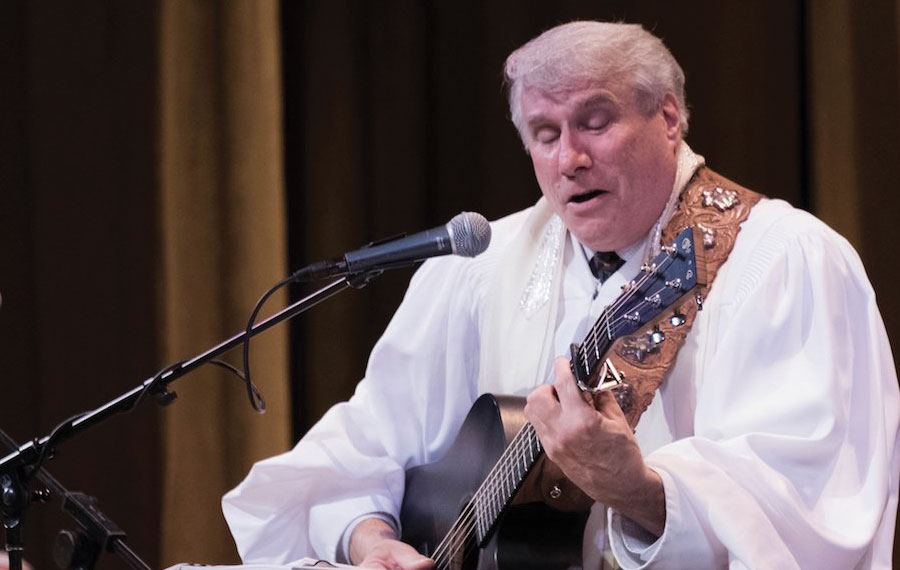 Photo courtesy of Cantor Doug Cotler
Photo courtesy of Cantor Doug Cotler During High Holy Days services 15 years ago, Congregation Or Ami Cantor Doug Cotler took a failed musical risk that haunts him to this day.
Along with the serious prayers including Avinu Malkeinu, Kol Nidre and Misheberach — the “war horses,” as Cotler calls them — he played an original song parody, “Back in the Temple,” a spoof of the Gene Autry country-western classic “Back in the Saddle Again.”
“I only do this once, thank God it will be 11 months until I’m back in the temple again,” Cotler sang over a hillbilly-rhythmic guitar. Unfortunately, all it produced was puzzled expressions among worshippers attending services for teshuvah, not satire, Cotler recalled during a phone interview.
“Some enjoyed it. But for most people, I think they are coming to High Holy Days services for introspection,” he said. “Performing that song may [have been] entertaining, but it did not function as prayer.”
Cotler, 68, doesn’t only serve as a cantor at his Reform synagogue. His resume extends beyond the bimah, including co-writing credit on “Manhunt,” which appears on the Grammy-winning 1983 soundtrack to “Flashdance.”
If marrying secular music with liturgy seems a strange combination, Cotler doesn’t seem to think so. “Imagine if John Lennon or Paul Simon wrote Jewish music,” he said. “That’s my approach.”
In that vein, he performs the late Debbie Friedman’s version of the Misheberach, a prayer for people in need of healing, because her music makes the Hebrew accessible, he said. “It’s very pop. It is not a complicated musical structure. It doesn’t demand operatic vocals. It’s music for the folk.”
“Imagine if John Lennon or Paul Simon wrote Jewish music. That’s my approach.”
— Cantor Doug Cotler
The son and grandson of cantors, and raised in a small farming town in California, Cotler said when it comes to choosing songs for services, he follows a model popularized by weddings: something old, something new, something borrowed and something blue.
Something from his grandfather’s era — “the old country” — or a hymn he learned during his childhood would qualify for something old. There is a lot to choose from, he said. “Jewish music is incredibly rich in its history.”
Something new, he said, could be a song by a contemporary musician. Cotler plans to perform a song by Daniel Cainer, a London-born artist whose intelligent lyrics highlight his tune “On Yom Kippur,” Cotler said.
“I may not be religious, it may all be hot air, but if I’m sincere for at least one day of the year, maybe I’ll find God there,” Cainer sings.
“He is having a conversation with God in the song, and he goes through a process,” Cotler explained. “It is a challenging song. Not everybody will relate to it. Not everybody is skeptical, but it is something new.”
For something borrowed, Cotler pointed to Cantor Azi Schwartz of New York’s Park Avenue Synagogue, and his rendition of “Adon Olam,” sung to the tune of “You’ll Be Back” from the Broadway hit “Hamilton.”
“It has a la-da-die part that occurs a few times [that] I thought would be a neat way to end Rosh Hashanah services as people leave to go to the beach for tashlich,” he said.
Finally, for something blue, Cotler said anything rock-and-roll, pop or “out of the Jewish realm for the High Holy Days” works. Just no forays into musical comedy, he quipped.
“I’m not so interested in shaking people up so much in that way during the High Holy Days,” Cotler said. “I’m mainly interested in people feeling at home, shaking them up internally, rather than forcing something so strange they’re more concerned about how weird it is musically.”























 More news and opinions than at a Shabbat dinner, right in your inbox.
More news and opinions than at a Shabbat dinner, right in your inbox.